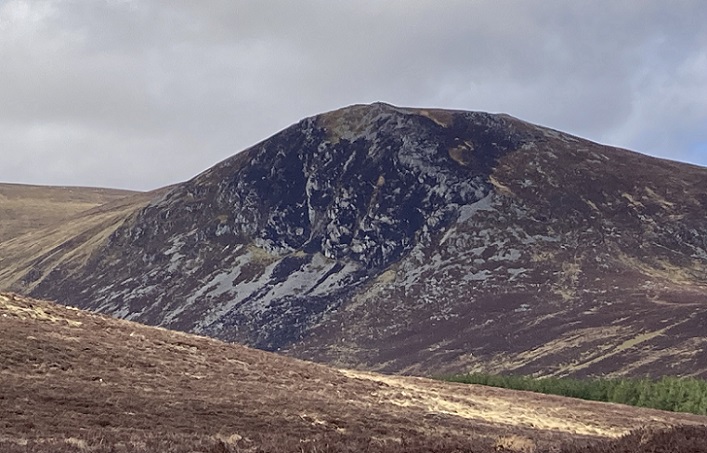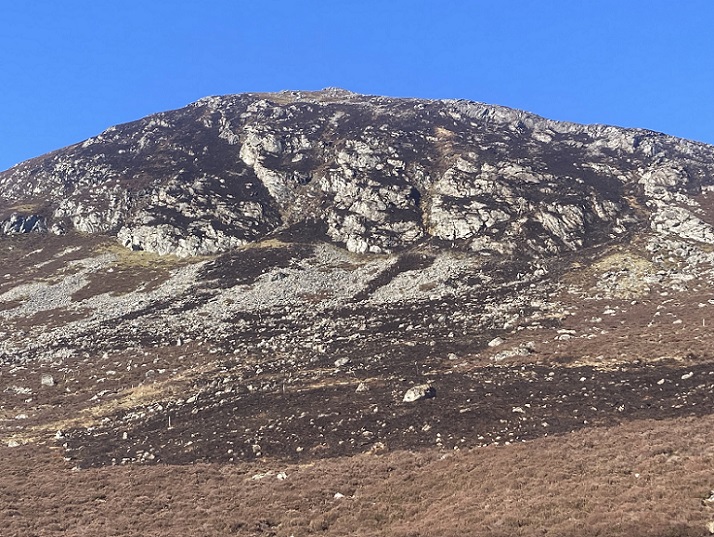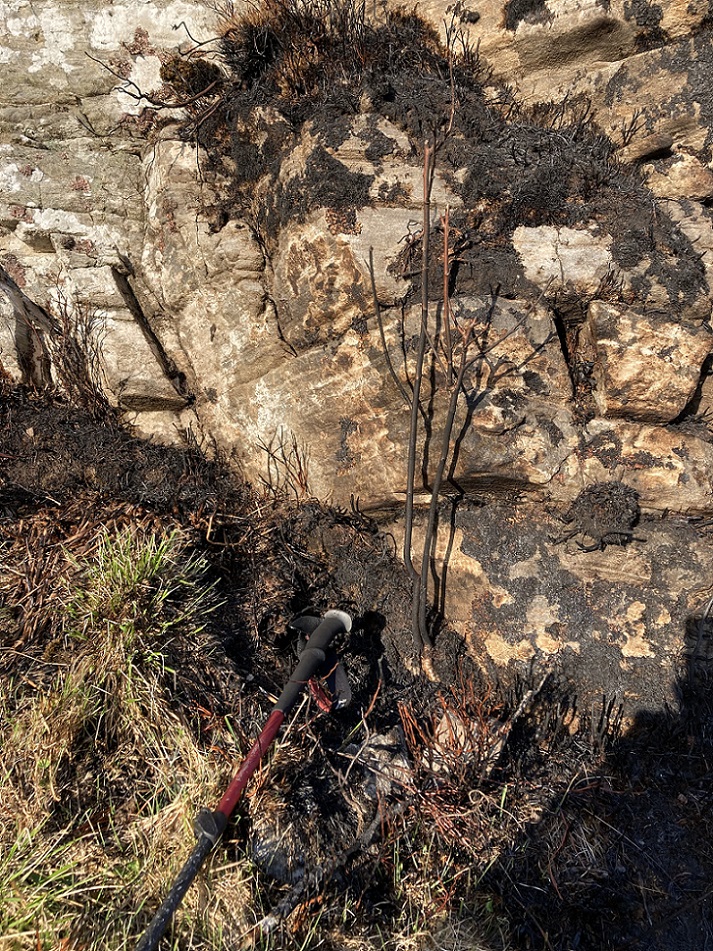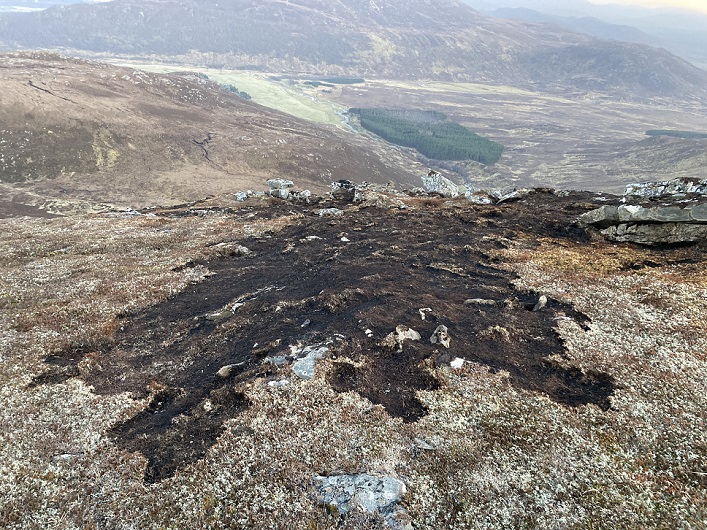
The Tinto Hills Site of Special Scientific Interest (SSSI) (see here) was not the only protected area to be destroyed by muirburn during the periods of high fire risk this Spring. The muirburn triggered wild fire considered in this post took place in the glen running north from Glenballoch in Glen Banchor which has previously featured on parkswatch for its landslips (see here). The two are not unconnected. Landslips are a predictable consequence of removing the vegetation on steep slopes by burning or overgrazing.

The NASA Firms database shows the fire took place on Thursday 20th March (see here) during a period in which the Scottish Fire and Rescue Service had issued warnings of very high fire risk (see here). The photo shows how the muirburn ran up the muirburn to the scree but then appears to have taken three main routes across and around the scree at the base of the crags before jumping up them and spreading further.

Creag na h-Iolaire (Eagle Crag) lies within the Monadliath Hill SSSI (see here), which is protected for its mosaic of upland habitats, and the Monadhliath Special Area of Conservation which is protected for its blanket bog. Included in the upland habitats are montane heath, montane willow scrub and “rare plants found on the heaths and cliffs include alpine bearberry and Scottish asphodel”. One hopes there have been previous botanic surveys of this crag but whatever the case NatureScot now needs to survey the crag to assess what has been destroyed by the muirburn and report on that publicly.

Muiirburn in SSSIs is an Operation Requiring Consent from NatureScot but, as with the Tinto Hills SSSI, NatureScot has not put any limits on where the Glenbanchor Estate can burn outside areas of blanket bog so long as the muirburn is carried out in accordance with the Muirburn code. That code, among many other provisions, currently advises not to burn on scree, not to burn on crags, not to burn on summit areas and for people who are not experienced not to burn on slopes over 18°(with those who are experienced not being able to burn over 27°). The photos show the muirburn created wildfire has done all those things. The case for much stronger controls over muirburn is obvious – far too much damage is being done to conservation areas of national importance by out-of-control muirburn, as in Glenbanchor and elsewhere. Instead therefore of NatureScot diluting those provisions as they propose doing (see here) and (here) – the consultation (see here) has now been extended to 5th May – as a bare minimum NatureScot should now use its powers to stop all muirburn in SSSIs.

The current Muirburn Code requires a minimum of three staff to be on site for safety purposes. I have heard from a landowning source, but have been unable to verify, that a single person started the fire and that when it got out of control he summoned help. I have not yet established whether the wildfire was ever reported to the Scottish Fire and Rescue Service or NatureScot. Those bodies should establish what happened from the Glenbanchor and Pitmain Estate’s factors, Savills, and its apparent owner, Majid Jafar, Chief Executive of Crescent Petroleum.(see here).

In 2022 Scottish Land and Estate claimed that the Pitmain and Glenbanchor Estate (see here) “has an outstanding record of habitat improvement. From aggressive peat restoration measures, to being one of the first estates involved in the pioneering South of Scotland Golden Eagle Project to the most recent Calder River Restoration project”. What SLE failed to say was that all those projects were/are being funded by the public purse while the rest of the land is being seriously impacted by overgrazing through excessive numbers of red deer and damaging muirburn. These conservation projects at best represent a sticking plaster over a small part of the bites and burns being inflicted on the natural world.

The SSSI Site Management Statement aims to improve the state of montane woodland in the Monadhliath SSSI, an admirable aspiration. Crags often provide the last refuge for such flora and the muirburn which incinerated Creag na h’Iolaire is a massive set back to this conservation aim. An investigation is needed to establish why this muirburn was allowed to spread over this cliff, a potentially reckless action which may be a criminal offence under the Wildlife and Countryside legislation. That should be of concern to Majid Jafar, who appears to have ultimate responsibility for estate management in association with the estate factors, Savills.

Given the role that muirburn plays in the destruction of nature in the National Park, one might have hoped the Cairngorms National Park Authority would have been advocating for stronger controls. Instead, it is proposing to make the landed estates who cause many of the wildfires in the National Park responsible for managing them and forking out public money to very rich landowners to buy fire fighting equipment. It will be very interesting to see whether the CNPA says anything about the Glenbanchor estate wildfire, the one in Glen Shee (see here) and all the other wildfires which have been caused by muirburn in its response to the consultation on the Muirburn Code. The time for the CNPA to adopt a far more robust attitude towards muirburn is long overdue

Lichen rich moorland is important not only for nature conservation but also for carbon capture. Carbon is stored in the sugars that accumulate in the fronds. That is why lichens are a main food source for reindeer. We need to encourage lichen growth on heather in moorlands everywhere. Repeated burning of moorland is not good for lichen growth – the lichen is either incinerated or killed by the smoke pollution.
What happened a month ago on the Glenbanchor estate is a consequence of Scotland’s system of landownership which at present places no restrictions on who can own land and minimum constraints on how it can be used, even in National Parks and other protected areas. As a result rather than restoring nature in Scotland, it continues to be destroyed or degraded in far too many areas. There are two ways of tackling this. The first is to introduce more controls over how land is used which should include a ban on muirban and to withdraw public subsidies completely from those who break the law. The second is through land reform and who can own land. That should include provisions to vet who is allowed to purchase land and for what purpose but also to compulsorily purchase land continues to be destroyed or degraded. Glenbanchor is an example of why a new approach is needed urgently.

Seeing as the estates are being gifted our money to help them buy fire fighting equipment, wouldn’t it be a reasonable expectation that the estates should also pay for SFR to attend their callouts?
I came across the evidence of a large out of control muir burn behind Cairnwell yesterday. I estimate half a square kilometer has been burned and only the path along the ridge to Carn a Gheoidh has checked its progress.